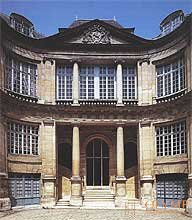
Continuing the traditions of the Renaissance (worship of the ancient ideals of harmony and measure, belief in the power of the human mind), classicism was also its peculiar antithesis, since with the loss of Renaissance harmony, unity of feeling and intelligence, the tendency of the aesthetic experience of the world as a harmonious whole was lost.  Concepts such as society and personality, man and nature, elements and consciousness, polarize in classicism, become mutually exclusive, which brings it together (while preserving all the cardinal global philosophical and stylistic differences) with the Baroque, also imbued with the consciousness of universal discord, generated by the crisis of Renaissance ideals.
Concepts such as society and personality, man and nature, elements and consciousness, polarize in classicism, become mutually exclusive, which brings it together (while preserving all the cardinal global philosophical and stylistic differences) with the Baroque, also imbued with the consciousness of universal discord, generated by the crisis of Renaissance ideals.
Classicism of the 17th century is usually distinguished. and classicism 18 — early 19 centuries. (the latter is often referred to as neo-classicism in foreign art history), but in the plastic arts, the tendencies of classicism began to appear in the second half of the 16th century. in Italy - in the architectural theory and practice of Palladio, the theoretical treatises of Vignola, S. Serlio; more consistently in the writings of J. P. Bellory (17th century), as well as in the aesthetic standards of academics of the Bologna school. 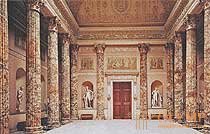 However, in the 17th century Classicism, which developed in a sharply polemical interaction with the Baroque, only in French artistic culture has developed into a coherent style system. In the bosom of French art culture, classicism of the 18th century was predominantly formed, becoming a pan-European style. The principles of rationalism underlying the aesthetics of classicism (the same ones that identified the philosophical ideas of R. Descartes and Cartesianism) determined the view of works of art as the fruit of reason and logic, triumphant over the chaos and fluidity of perceptionally perceived life. Only the eternal, timeless, has aesthetic value in classicism. Giving great importance to the social function of art, classicism puts forward new ethical norms that form the image of its heroes: perseverance before the cruelty of fate and the vicissitudes of life, the subordination of the personal to the general, the passions to duty, reason, the supreme interests of society, the laws of the universe. Orientation to a rational beginning, to enduring patterns determined the normative requirements of the aesthetics of classicism, the regulation of artistic rules, a strict hierarchy of genres - from "high" (historical, mythological, religious) to "low" or "small" (landscape, portrait, still life) ; each genre had strict substantive boundaries and clear formal signs. The consolidation of the theoretical doctrines of classicism was promoted by the activities of the Royal Academies based in Paris - painting and sculpture (1648) and architecture (1671).
However, in the 17th century Classicism, which developed in a sharply polemical interaction with the Baroque, only in French artistic culture has developed into a coherent style system. In the bosom of French art culture, classicism of the 18th century was predominantly formed, becoming a pan-European style. The principles of rationalism underlying the aesthetics of classicism (the same ones that identified the philosophical ideas of R. Descartes and Cartesianism) determined the view of works of art as the fruit of reason and logic, triumphant over the chaos and fluidity of perceptionally perceived life. Only the eternal, timeless, has aesthetic value in classicism. Giving great importance to the social function of art, classicism puts forward new ethical norms that form the image of its heroes: perseverance before the cruelty of fate and the vicissitudes of life, the subordination of the personal to the general, the passions to duty, reason, the supreme interests of society, the laws of the universe. Orientation to a rational beginning, to enduring patterns determined the normative requirements of the aesthetics of classicism, the regulation of artistic rules, a strict hierarchy of genres - from "high" (historical, mythological, religious) to "low" or "small" (landscape, portrait, still life) ; each genre had strict substantive boundaries and clear formal signs. The consolidation of the theoretical doctrines of classicism was promoted by the activities of the Royal Academies based in Paris - painting and sculpture (1648) and architecture (1671).
The architecture of classicism as a whole has a logical layout and geometrism of a volumetric shape. 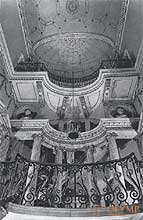 The constant appeal of classical architects to the heritage of ancient architecture implied not only the use of its individual motifs and elements, but also the comprehension of the general laws of its architectonics. The basis of the architectural language of classicism was a warrant, in proportions and forms closer to antiquity than in the architecture of previous eras; in buildings, it is used in such a way that it does not obscure the general structure of the structure, but becomes its subtle and restrained accompaniment. The interior of classicism is characterized by clarity of spatial articulation, softness of colors. Widely using perspective effects in monumental-decorative painting, the masters of classicism essentially separated the illusory space from the real. The urban planning of classicism of the 17th century, genetically connected with the principles of the Renaissance and Baroque, actively developed (in the plans of the fortresses) the concepts of the "ideal city", created its own type of residence (Versailles). In the 2nd floor. 18th century new planning methods are being developed that provide for an organic connection of city building with elements of nature, the creation of open spaces that spatially merge with a street or embankment. The subtlety of the laconic decor, the expediency of the forms, and the unbreakable connection with nature are inherent in the buildings (mainly country palaces and villas) of representatives of Palladianism 18 — early. 19th century
The constant appeal of classical architects to the heritage of ancient architecture implied not only the use of its individual motifs and elements, but also the comprehension of the general laws of its architectonics. The basis of the architectural language of classicism was a warrant, in proportions and forms closer to antiquity than in the architecture of previous eras; in buildings, it is used in such a way that it does not obscure the general structure of the structure, but becomes its subtle and restrained accompaniment. The interior of classicism is characterized by clarity of spatial articulation, softness of colors. Widely using perspective effects in monumental-decorative painting, the masters of classicism essentially separated the illusory space from the real. The urban planning of classicism of the 17th century, genetically connected with the principles of the Renaissance and Baroque, actively developed (in the plans of the fortresses) the concepts of the "ideal city", created its own type of residence (Versailles). In the 2nd floor. 18th century new planning methods are being developed that provide for an organic connection of city building with elements of nature, the creation of open spaces that spatially merge with a street or embankment. The subtlety of the laconic decor, the expediency of the forms, and the unbreakable connection with nature are inherent in the buildings (mainly country palaces and villas) of representatives of Palladianism 18 — early. 19th century
The tectonic clarity of the classical architecture corresponds to a clear delineation of plans in sculpture and painting. 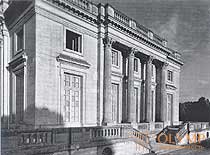 The plastic of classicism, as a rule, is designed for a fixed point of view, is distinguished by smoothness of forms. The moment of movement in the postures of the figures usually does not violate their plasticity. isolation and calm statuarity. In the painting of classicism, the basic elements of the form are the line and chiaroscuro (especially in late classicism, when painting sometimes leads to monochrome, and graphics - to pure linearity); the local color clearly reveals objects and landscape plans (brown for near, green for medium, blue for background), which brings the spatial composition of the pictorial work closer to the composition of the stage.
The plastic of classicism, as a rule, is designed for a fixed point of view, is distinguished by smoothness of forms. The moment of movement in the postures of the figures usually does not violate their plasticity. isolation and calm statuarity. In the painting of classicism, the basic elements of the form are the line and chiaroscuro (especially in late classicism, when painting sometimes leads to monochrome, and graphics - to pure linearity); the local color clearly reveals objects and landscape plans (brown for near, green for medium, blue for background), which brings the spatial composition of the pictorial work closer to the composition of the stage.
The founder and the greatest master of classicism of the 17th century. was a French artist N. Poussin, whose paintings are marked by the elevation of the philosophical and ethical content, the harmonious rhythmic structure and color. High development in the painting of classicism of the 17th century. He received the "perfect landscape" (Poussin, C. Lorrain, G. Dughet), who embodied the classicists' dream of a "golden age" of humanity. The formation of classicism in the French architecture is associated with the buildings of F. Mansart noted by the clarity of the composition and order divisions. High samples of mature classicism in the 17th century architecture are the eastern façade of the Louvre (C. Perrot), the works of L. Levo, F. Blondel. From the 2nd floor. 17th century French classicism incorporates some necrotic elements of Baroque architecture (Palace and Park of Versailles - architect J. Ardouin-Mansart, A. Lenotre). In the 17th and early 18th centuries. Classicism was formed in the architecture of Holland (architect J. van Kampen, P. Post), which gave birth to a particularly restrained version of it, and in England’s “Palladian” architecture (architect I. Jones), where the national version was finally formed in the works of K. Ren. English classicism. Cross-ties with French and Dutch classicism, as well as with the early baroque, were reflected in the short brilliant flourishing of classicism in the architecture of Sweden in the late 17th and early 18th centuries. (architect N. Tessin the Younger).
In the middle of the 18th century the principles of classicism were transformed in the spirit of the aesthetics of the Enlightenment. In architecture, the appeal to "naturalness" put forward the requirement of the constructive justification of the order elements of the composition; in the interior, the development of a flexible layout of a comfortable residential building. The ideal environment of the house was the landscape environment of the “English” park. A huge impact on the classicism of the 18th century. has had a rapid development of archaeological knowledge of Greek and Roman antiquity (excavations of Herculaneum, Pompeii, etc.); The contributions of I. I. Winkelman, I. V. Goethe, and F. Militia contributed to the theory of classicism. In the French classicism of the 18th century. new architectural types were defined: an exquisitely intimate mansion, a grand public building, an open city square (architect J. A. Gabriel, J. J. Suflo). Civic pathos and lyricism were combined in plastic by J. B. Pigalle, E. M. Falcone, J. A. Houdon, in the mythological painting by J. M. Vien, decorative landscapes by J. Robert. The eve of the Great French Revolution (1789–94) gave rise to a striving for harsh simplicity in architecture, a bold search for monumental geometrism of new, beeorder architecture (C. N. Ledoux, E. L. Bullet, J. J. Leke). These searches (also marked by the influence of architectural etchings by J.B. Piranesi) served as the starting point for the late phase of classicism, Empire. The painting of the revolutionary trend of French classicism is represented by the courageous drama of historical and portrait images of J. L. David. In the years of Napoleon’s empire, magnificent representation increases in architecture (S. Persier, P. F. Fontwn, J. F. Shalgren). Paintings of late classicism, despite the appearance of some great masters (J. O. D. Engr), degenerates into official apologetic or sentimental erotic salon art.
The international center of classicism of the 18th — early 19th centuries. became Rome, where academic tradition dominated art with a combination of nobleness of form and cold, abstract idealization that is not uncommon for academism (German painter A. R. Mengs, Austrian landscape painter J. A. Koch, sculptors — Italian A. Canova, Dane B. Thorvaldsen} For German classicism of the 18th — early 19th centuries, strict forms of the Palladian F. V. Erdmansdorf, the “heroic” Hellenism of CG Langthans, D, and F. Gilles are characteristic of arhra. In the works of K. F. Schinkepia, the top of the late German classicism in architecture - austere monumentalism images combined with the search for new functional solutions.In the visual art of German classicism, contemplative in spirit, stand out portraits of A. and V. Tishbeinov, mythological cardboard A. Ya. Carstens, plastics IG Shadova, KD Rauch; -applied art - furniture D. Roentgen. In the 18th century English architecture was dominated by the Palladian trend, closely associated with the flourishing of suburban park estates (architects W. Kent, J. Pein, W. Chambers). The discoveries of ancient archeology were reflected in the special grace of the order decoration of the buildings of R. Adam. At the beginning of the 19th century in English architecture features of the Empire style (J. Soun). The national achievement of English classicism in architecture was a high level of culture in the design of a residential estate and city, bold urban planning initiatives in the spirit of the idea of a city-garden (architects J. Wood, J. Wood Jr., J. Nash). 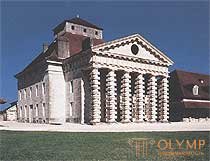 In other arts, the closest to the classicism of graphics and sculpture is J. Flaxman, in decorative and applied art - ceramics by J. Wedgwood and the masters of the factory in Derby. In the 18th and early 19th centuries. Classicism is also established in Italy (architect J. Piermarini), Spain (architect X. de Villanueva), Belgium, Eastern Europe, Scandinavia, in the USA (architect G. Jefferson. J. Hoban; painters B. West and J. S. Collie). At the end of the 1st third of the 19th century. the leading role of classicism is fading; in the 2nd half of the 19th century Classicism is one of the pseudo-historical styles of eclecticism. At the same time, the artistic tradition of classicism comes alive in the neo-classicism of the 2nd half of the 19th and 20th centuries.
In other arts, the closest to the classicism of graphics and sculpture is J. Flaxman, in decorative and applied art - ceramics by J. Wedgwood and the masters of the factory in Derby. In the 18th and early 19th centuries. Classicism is also established in Italy (architect J. Piermarini), Spain (architect X. de Villanueva), Belgium, Eastern Europe, Scandinavia, in the USA (architect G. Jefferson. J. Hoban; painters B. West and J. S. Collie). At the end of the 1st third of the 19th century. the leading role of classicism is fading; in the 2nd half of the 19th century Classicism is one of the pseudo-historical styles of eclecticism. At the same time, the artistic tradition of classicism comes alive in the neo-classicism of the 2nd half of the 19th and 20th centuries.
The heyday of Russian classicism dates back to the last third of the 18th and 1st third of the 19th centuries, although already at the beginning of the 18th century. marked creative appeal (in the architecture of St. Petersburg) to the urban planning experience of French classicism of the 17th century. (principle of symmetrical axial planning systems). Russian classicism embodied a new, unprecedented for Russia in scope, national pathos and ideological fullness of the historical stage of the flowering of Russian secular culture. Early Russian classicism in architecture (1760–70s; J.-B. Vallen-Delamot, A.F. Kokorinov, Yu.M. Velten, K.I. Blank, A.Rinaldi) also preserves plasticity, enrichment and baroque and rococo dynamics of forms. The architects of the mature pores of classicism (1770–90s; V.I. Bazhenov, M.F. Kazakov, I.Ye. Starov) created the classic types of the Moscow palace-estate and large comfortable apartment building, which became models in the broad construction of suburban noble estates and in the new, ceremonial buildings of cities. The art of ensemble in country park manors is a major national contribution of Russian classicism to the world artistic culture. The Russian version of Palladianism (N.A. Lvov) arose in the estate construction, a new type of chamber palace was formed (C. Cameron, J. Quarenghi}. 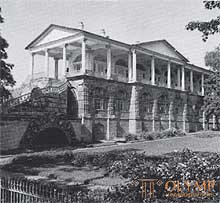 The peculiarity of Russian classicism in architecture is the unprecedented scale of organized state urban planning: regulatory plans were developed for more than 400 cities, ensembles of Kostroma, Poltava, Tver, Yaroslavl and other cities were formed; The practice of "regulating" city plans, as a rule, successively combined the principles of classicism with the historically established planning structure of the old Russian city. The turn of the 18-19 centuries. marked by the greatest urban development achievements in both capitals. A grandiose ensemble of the center of St. Petersburg (A.N. Voronikhin, A.D. Zakharov, J.T. de Gomon, later K.I. Rossi) was formed. On other town-planning principles, “classical Moscow” was formed, built up during the period of its restoration and reconstruction after the fire of 1812 in small mansions with cozy interiors. The beginnings of regularity here were consistently subordinated to the general scenic freedom of the spatial structure of the city. The most prominent architects of late Moscow classicism are D.I. Zhilardi, O.I.Bove, A.G. Grigoriev.
The peculiarity of Russian classicism in architecture is the unprecedented scale of organized state urban planning: regulatory plans were developed for more than 400 cities, ensembles of Kostroma, Poltava, Tver, Yaroslavl and other cities were formed; The practice of "regulating" city plans, as a rule, successively combined the principles of classicism with the historically established planning structure of the old Russian city. The turn of the 18-19 centuries. marked by the greatest urban development achievements in both capitals. A grandiose ensemble of the center of St. Petersburg (A.N. Voronikhin, A.D. Zakharov, J.T. de Gomon, later K.I. Rossi) was formed. On other town-planning principles, “classical Moscow” was formed, built up during the period of its restoration and reconstruction after the fire of 1812 in small mansions with cozy interiors. The beginnings of regularity here were consistently subordinated to the general scenic freedom of the spatial structure of the city. The most prominent architects of late Moscow classicism are D.I. Zhilardi, O.I.Bove, A.G. Grigoriev.
 In the visual arts, the development of Russian classicism is closely connected with the Petersburg Academy of Arts (founded in 1757). The sculpture of Russian classicism is represented by the “heroic” monumental-decorative plastic art, made up of finely thought out synthesis with an empire architecture, monuments filled with pathos of civil, elegance-graved gravestones, and easel plasticity (I. P. Prokofiev, F. G. Gordeev, M. I. Kozlovsky , I. P. Martos, F. F. Shchedrin, V. I. Demuth-Malinovsky, S. S. Pimenov, I. I. Terebenev). Russian classicism in painting was most pronounced in the works of the historical and mythological genres (A. P. Losenko, G. I. Ugryumoe, I. A. Akimov, A. I. Ivanov, A. E. Egorov, V. K. Shebuev, Early A. A. Ivanov). Nekrye features of classicism are also inherent in fine psychological sculptural portraits of F. I. Shubin, in painting - portraits of D. G. Levitsky, V. L. Borovikovsky, landscapes of F. M. Matveyev. Artistic modeling and carving in architecture, bronze articles, cast iron, porcelain, crystal, furniture, damask fabrics, etc., stand out in the decorative and applied art of Russian classicism. From the 2nd third of the 19th century. For the fine art of Russian classicism, soulless, contrived academic schematism — the so-called “decline” —inherent in every bright period in art, is becoming increasingly characteristic.
In the visual arts, the development of Russian classicism is closely connected with the Petersburg Academy of Arts (founded in 1757). The sculpture of Russian classicism is represented by the “heroic” monumental-decorative plastic art, made up of finely thought out synthesis with an empire architecture, monuments filled with pathos of civil, elegance-graved gravestones, and easel plasticity (I. P. Prokofiev, F. G. Gordeev, M. I. Kozlovsky , I. P. Martos, F. F. Shchedrin, V. I. Demuth-Malinovsky, S. S. Pimenov, I. I. Terebenev). Russian classicism in painting was most pronounced in the works of the historical and mythological genres (A. P. Losenko, G. I. Ugryumoe, I. A. Akimov, A. I. Ivanov, A. E. Egorov, V. K. Shebuev, Early A. A. Ivanov). Nekrye features of classicism are also inherent in fine psychological sculptural portraits of F. I. Shubin, in painting - portraits of D. G. Levitsky, V. L. Borovikovsky, landscapes of F. M. Matveyev. Artistic modeling and carving in architecture, bronze articles, cast iron, porcelain, crystal, furniture, damask fabrics, etc., stand out in the decorative and applied art of Russian classicism. From the 2nd third of the 19th century. For the fine art of Russian classicism, soulless, contrived academic schematism — the so-called “decline” —inherent in every bright period in art, is becoming increasingly characteristic.
Что бы оставить комментарий войдите
Комментарии (0)